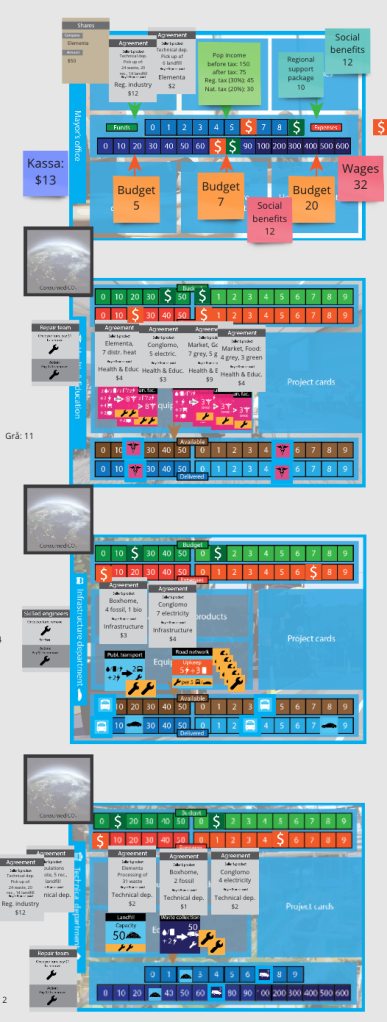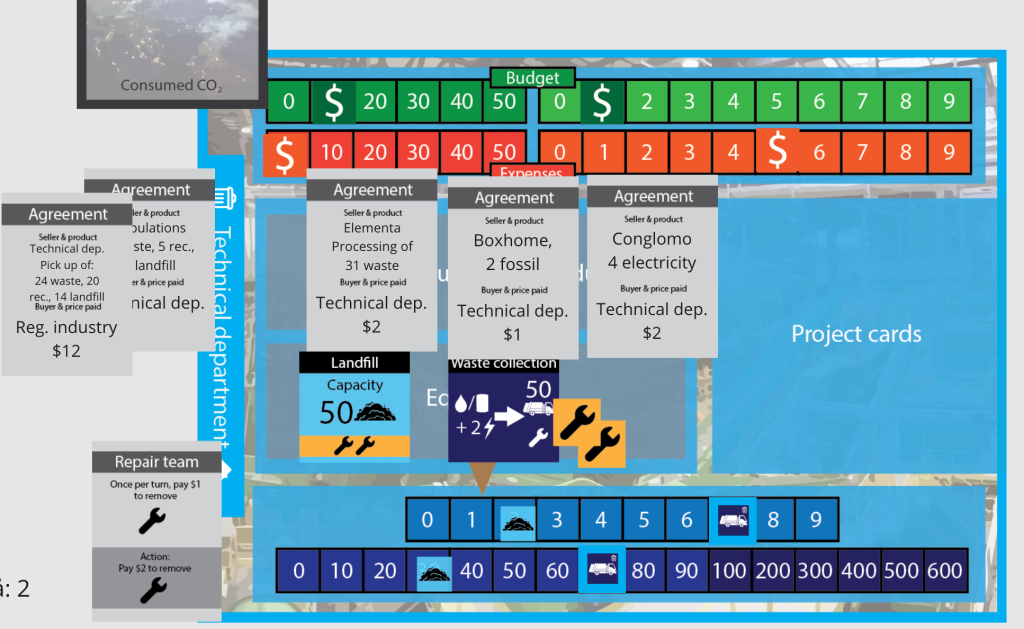

In this post, I’ll discuss the local authorities boards, which expanded quite a lot between Playtests 1 and 2. This was not entirely due to the fact that Playtest 2 involved people working in the local authorities, but also that the two players that played the local authorities during Playtest 1 was quite confused by the many different areas in which they were involved: healthcare/schools, waste management, and the public transportation system. Thus, I divided up the local authorities in three departments with one board each, and added a fourth called the Mayor’s office, handling all financial matters and receiving instructions regarding how to manage the municipality from the Regional Council, consisting of one player from each population team.
This seemed to work reasonably well for the three department players (one per department, sitting around one table) – they didn’t seem overworked and had time to interact with other players around project cards. The Mayor and her financial advisor, on the other hand, who sat at a separate table a few yards away, were busy talking to other players coming to their table every minute of the order phases of both turns. I failed to give the members of the Regional Council clear instructions regarding where and how they were to meet, and so they got stuck halfway to the council chamber/Mayor’s table on the first turn, meaning the Mayour didn’t speak much with them. This was remedied during the second turn, and the politicians spent more time at the Mayor’s table – however, the Mayor hardly spoke a word with her department heads, meaning that the initiative for the few changes they made didn’t come from the Mayor’s office and/or Regional Council. This part of the game will undergo development as I now have a better understanding of the way players see the roles and how negotiations work – one thing that may be attempted is to have a stricter round structure, so that the Regional Council will have scheduled, set-agenda meetings with the Mayor, followed by a meeting between the Mayor and the departments heads to set the budget.
Although all three departments are important in their own way, the Health & Education department were criticized the most for not being able to provide all the service the populations desired (which was by design from the start of the game). However, this system was quite straightforward, which was not the case with the waste collection system. In Playtest 1, only the part of household waste that goes to the waste-to-energy plants were included, which meant that all waste was placed on the population boards, and frankly ignored as no changes to the amount of waste was done during the three turns the game lasted. In Playtest 2, a division into waste, recycling, and landfill was made, and – based on data on handling of waste in Sweden – only 25% of all waste was placed on the population boards and the rest on Regional industries, as a representation of all other businesses in the region.





This part of the game was not used much in either playtest, which indicates either that it is as yet not an important part – it is in reality, however, as the district heating system is heavily dependent on access to waste, and the region is heavily invested in its district heating system – or that it was difficult to understand, possibly due to being distributed all over the room and half a dozen boards. This needs to be looked at in more detail in the future, but this does not necessarily mean the system needs to become more detailed and complex – perhaps it could be reduced to domestic market access to burnable waste and the Technical department board discarded. As waste and consumer goods are tightly linked, there should perhaps be a separate ‘waste board’ that allows players to see and change this part of the energy system from a slightly different perspective.
The maintenance system was added to the game for Playtest 2 to represent costs involved in maintaining complex systems. The system is quite simple – for each building, roll two dice and add the number of wrench symbols printed on both the building itself and any tokens on top of it – and were received quite well. How to remove the tokens was described on cards (Repair team and Skilled engineers) given to the players, and this took a bit of time for them to connect. The timing of when to roll was also a bit unclear, and may be remedied by clearer game turn structure sheets being printed and handed out to players and Control next time.

Overall, the local authorities boards will undergo changes based on whether it is deemed they are contributing to the game experience – that the local authorities are an important piece of the overall puzzle is beyond doubt, but in which way they are to be played is as yet not clear. When creating the Mayor’s office quite a few financial aspects gathered there – almost by themselves, it seemed – and so gave rise to the idea that the financial aspect of the game needs to be expanded, not least to enable Control to throw interesting challenges at players in relation to the monetary system. This is the topic of the final post in this four-post expose of the two first playtests, and will involve some discussion of possible scenarios that the players can encounter and how the project cards, which we have just mentioned in passing so far, may come to impact the game.
